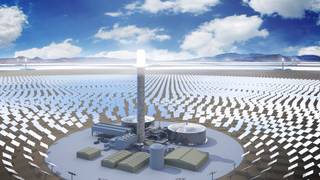
Courtesy Photo
A rendering of SolarReserve’s ten new solar plants expected to cover about 15,000 acres and create 3,000 construction jobs over seven years.
Tuesday, Oct. 25, 2016 | 2 a.m.
Related content
When California-based energy firm SolarReserve began generating electricity in Nevada at the end of 2015, the news was cast as a significant step in the future of solar power. Unlike rooftop panels or large-scale solar arrays, SolarReserve’s project — about 200 miles from Las Vegas and known as Crescent Dunes — converts sunlight into electricity both day and night.
SolarReserve intends to build a vast $5 billion solar project in Nevada that will comprise 10 solar plants and deliver power back to California. It is expected to cover about 15,000 acres and create 3,000 construction jobs over seven years.
Most power companies receive solar energy during the day and rely on more traditional resources, such as natural gas, at night. Technological developments are starting to change that dynamic. Industrial batteries, which store excess energy from the photovoltaic cells on solar panels, allow energy managers to use stored solar power when the sun’s not shining.
SolarReserve’s projects such as Crescent Dunes use thousands of mirrors to direct sunlight toward a tower with molten salt, which absorbs heat and reaches temperatures as high as 1050 degrees Fahrenheit. Because the molten salt, used to boil water and drive steam-powered generators, can be stored for up to 16 hours, plant operators can transfer heat and provide electricity throughout the day.
The company believes that despite high upfront costs, its projects will be more competitive than storage batteries and could provide an environmentally-friendly path for solar energy generation. Once completed in several years, the new project will be massive. While Crescent Dunes has one molten-salt tower, the recently announced $5-billion venture will be a 10-tower project.
“It will be about equivalent to the energy of the Hoover Dam,” said Kevin Smith, the company’s CEO.
Smith spoke with the Sun about the scale and why SolarReserve built in Nevada. Here are some highlights:
You’re now potentially going to have two projects in Nevada. I’m curious why you chose Nevada?
A few reasons. Probably the main three are what we would consider a favorable regulatory environment, ample available land and good solar resources. There are a number of other reasons as well. You know we already developed one project there so we kind of know the landscape… It is certainly more difficult to get projects built in California even though that could be the ultimate destination for a good portion of the power. But we see Nevada’s regulatory environment and political environment as very cooperative with renewable energy projects.
You mentioned California. Was Nevada’s proximity to California a factor as well?
Exactly. California is obviously a big market for renewable energy. They’ve got a 50-percent target for renewable energy, and they’re not going to do that without a substantial amount of energy storage. They’re not going to be able to keep building (photovoltaics) and wind and expect to meet those targets… We believe we’ve got the most cost-competitive storage solution.
As storage batteries and other technologies come online, do you think you will be able to compete with them in terms of the cost?
Yeah. Right now, if you look at the cost of batteries and not just the upfront capital costs but degradation issues and replacement issues, our molten-salt systems will last for 30-40 years without degradation. And we’re substantially cheaper than batteries now… People are forecasting battery costs will come down in the next 3-5 years. But even at the forecasted cost in 3-5 years, we’re substantially cheaper than battery costs.
What was the impetus for building this second project?
There are two things. One is our Crescent Dunes project. Now we’ve proven out the technology. The storage technology is performing as designed. And really, we felt that the U.S. was starting to move more toward the (photovoltaics) plus battery model, which we believe is expensive and not very environmentally-sensitive structure to go toward. Batteries have a lot of issues, not only with costs but with degradation and disposal issues and manufacturing issues. We didn’t want the market to get too far embedded into the battery culture and thought that our storage solution was a much better option than (photovoltaics) plus batteries, in terms of cost and environmental concerns.
How large will the $5 billion project be?
It will be about 15,000-20,000 acres, which seems like a lot of land. But that’s the one thing that Nevada has a lot of, in addition to sunshine and a good workforce... There is a lot of land available… We would require (about .03 percent) of federal land in Nevada to build this project, which is a pretty proverbial drop in the bucket.
What’s next?
We’ve been working on the project for about 18 months and we’ve looked at 15 or 20 different sites, not only just Nevada. Obviously we’ve been looking at California and Arizona sites. But we thought that Nevada was the best place to locate the project. We boiled it down to two sites in Nye County. We’ll be making that final site selection in the next six months.
Do you expect to build more plants in the future?
We do. We’re pretty active internationally. Our next project we expect to build is essentially identical to the Crescent Dunes project in Nevada, which will be (constructed in) South Africa… We have projects in development in other parts of the world, including multi-tower projects in Chile. We’re looking at a multi-tower project in Morocco… So the project that we’re looking to site in Nevada isn’t necessarily unique in our portfolio in that we’re looking at a lot of multi-tower projects around the world.


Join the Discussion:
Check this out for a full explanation of our conversion to the LiveFyre commenting system and instructions on how to sign up for an account.
Full comments policy